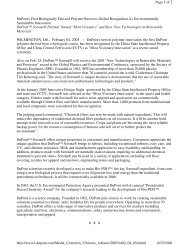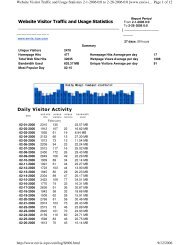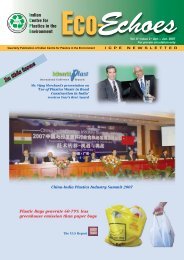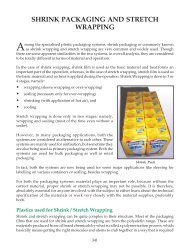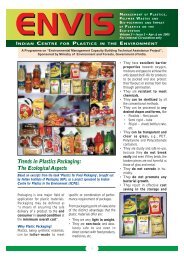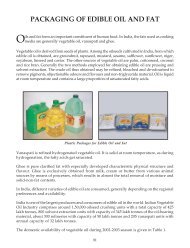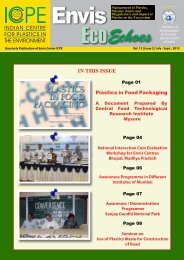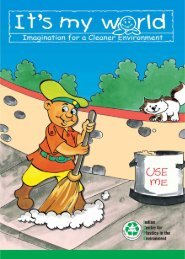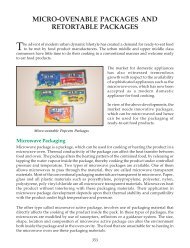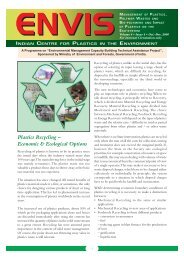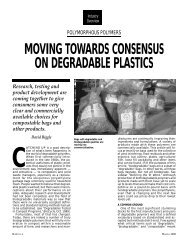packaging of ready-to-eat/ready-to- cook food - Indian Centre for ...
packaging of ready-to-eat/ready-to- cook food - Indian Centre for ...
packaging of ready-to-eat/ready-to- cook food - Indian Centre for ...
Create successful ePaper yourself
Turn your PDF publications into a flip-book with our unique Google optimized e-Paper software.
thermoplastics <strong>for</strong> dual-ovenable packages are dimensional stability up <strong>to</strong> 200°C <strong>to</strong> 250°C, good<br />
impact strength at freezer temperatures <strong>to</strong> reduce shipping and s<strong>to</strong>rage damage and<br />
microwaveability. Other important properties include compliance with FDA regulations,<br />
absence <strong>of</strong> taste and odour, good release characteristics so that the <strong>food</strong> does not stick. This<br />
property is very important <strong>for</strong> baked <strong>food</strong>. The different types <strong>of</strong> dual ovenable packages are<br />
explained here.<br />
Ovenable Plastic Based Food Trays<br />
These trays are manufactured by therm<strong>of</strong>orming sheets <strong>of</strong> polypropylene (PP), high impact<br />
polystyrene (HIPS) and crystalline polyethylene terephthalate (CPET), each material <strong>of</strong>fering<br />
specific advantages in per<strong>for</strong>mance and economics. The trays are vacuum <strong>for</strong>med or<br />
therm<strong>of</strong>ormed from a reel <strong>of</strong> sheet.<br />
When extended shelf-life is required, PP is co-extruded with barrier resins such as EVOH <strong>to</strong><br />
improve barrier properties <strong>for</strong> <strong>for</strong>ming. PP trays cannot withstand conventional oven<br />
temperatures and are used only <strong>for</strong> microwave ovens. Foamed polystyrene trays with special<br />
blends <strong>of</strong> low density polystyrene can withstand much higher temperatures, however, they<br />
are used generally only <strong>for</strong> microwave with an advantage <strong>of</strong> good cost saving as compared <strong>to</strong><br />
the CPET trays. CPET trays have distinct advantage <strong>of</strong> dual ovenability. They also very<br />
remarkably withstand the abuse <strong>of</strong> retail distribution. Their other advantages include design<br />
flexibility, resistance <strong>to</strong> oil and grease and no appreciable effect on <strong>food</strong> taste. CPET trays are<br />
stable from – 40°C <strong>to</strong> as high as 200°C and exhibit improved oxygen and water vapour<br />
barrier.<br />
All plastic trays are <strong>to</strong>pped with h<strong>eat</strong>-sealable lidding films or snap-on plastic domes.<br />
Ovenable Board<br />
Earlier developments were based on paperboard coated with TPX. This was expensive and<br />
the preferred material now is solid bleached sulphate board, extrusion coated with polyethylene<br />
terephthalate (PET). This material is resistant <strong>to</strong> exposure in hot-air ovens and <strong>to</strong> temperatures<br />
<strong>of</strong> 200-250°C. It is also used <strong>for</strong> containers <strong>for</strong> <strong>food</strong> <strong>to</strong> be re-h<strong>eat</strong>ed in microwave ovens<br />
only.<br />
The coated board is made in<strong>to</strong> containers by two main methods. One technique produces<br />
containers by press <strong>for</strong>ming <strong>to</strong> give trays or dishes similar <strong>to</strong> the conventionally pressed foil<br />
trays. An alternative system is based on existing car<strong>to</strong>n technology and erects trays from flat<br />
car<strong>to</strong>n blanks. The main reasons <strong>for</strong> the current interest in ovenable board trays are:<br />
• Growing popularity <strong>of</strong> convenience <strong>food</strong><br />
• Developments <strong>of</strong> the microwave oven<br />
• Developments <strong>of</strong> polyester coated ovenable board that is suitable <strong>for</strong> use in both microwave<br />
and conventional hot - air ovens<br />
Ovenable board containers have <strong>to</strong> satisfy a number <strong>of</strong> per<strong>for</strong>mance requirements. First and<br />
<strong>for</strong>emost, the material must be permeable <strong>to</strong> microwave radiation. Metal surface reflects<br />
microwave radiation so that the aluminium foil dishes are not really suitable <strong>for</strong> microwave<br />
oven use. Containers intended <strong>for</strong> general use must also be h<strong>eat</strong> resistant at temperatures up<br />
158



